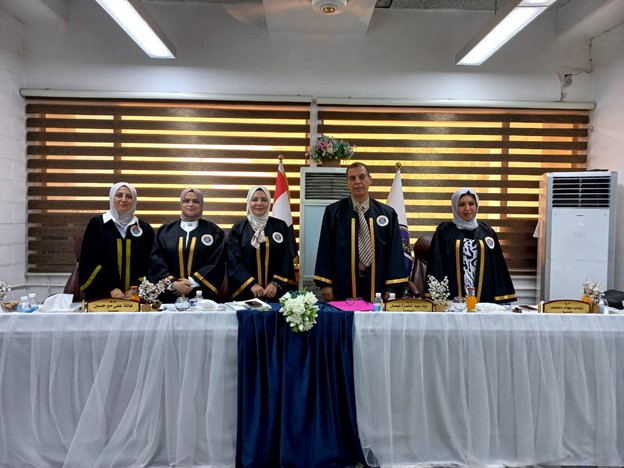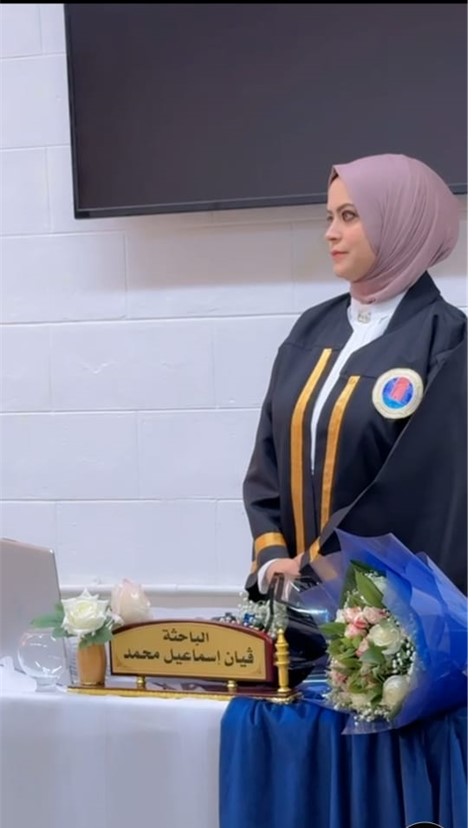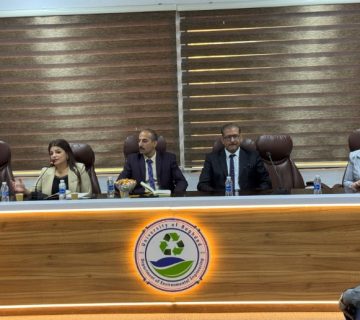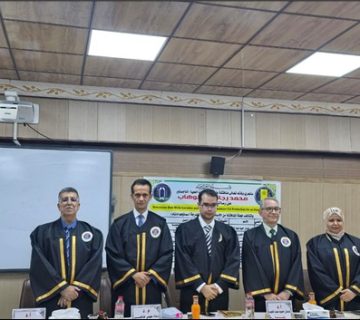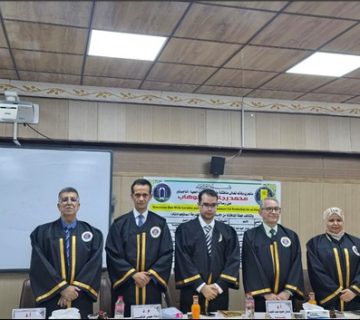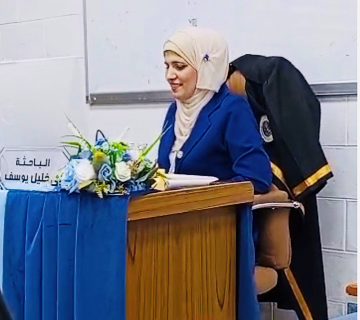The College of Engineering at the University of Baghdad held the public defense of M.Sc student Viyan Ismail Mohammed for his dissertation titled:
“Advanced Oxygen Processes (AOPs) For Removing Black Azo Dye from Aqueous Solutions Using Heterojunction Nanocomposite”
This event took place on Thursday, April 24, 2025, in the discussion hall of the Department of Environmental Engineering, under the supervision of Prof. Dr. Abeer Ibrahim. The examination committee consisted of Prof. Dr. Ayad Abdul Hamza Faisal, Prof. Dr. Zainb Baha’a Mohammed and Lec.Dr. Hala Ali Meer Hussein.
The current work presents the design of a Z-scheme heterojunction as a practical method for obtaining high reactive potential photogenerated charge carriers. The g-C3N4/Fe3O4/Ag2O nanocomposite was synthesized by co-precipitating of Fe₃O₄ and Ag₂O nanoparticles onto the g-C₃N₄ surface, improved by biosynthesis from Trumpet vine leaf extract. Green synthesized Ag2O nanoparticles were also fabricated, and the resulting nanomaterials were extensively characterized. The X-ray diffraction (XRD), Fourier-transform infrared spectroscopy (FTIR), transmission electron microscopy (TEM), Scanning Electron Microscopy (SEM), and vibrating sample magnetometer (VSM), showed investigations unequivocally demonstrated the successful synthesis of the g-C3N4/Fe3O4/Ag2O nanocomposite nanostructures. The photocatalytic removal of soluble black azo dye was studied under visible-light degradation using a batch reactor. The photoreactor is composed of a 1000 mL Pyrex glass vessel attached to a system of light-emitting diode 200W (LED) lamps. The ternary g-C3N4/Fe3O4/Ag2O heterojunction (0.6g/L) attained exceptional black Azo dye (5 mg/L, pH = 7) photo-efficiencies of 96.5%in 120min under visible light. g-C3N4/Fe3O4/Ag2O nanocomposite was capable of photodegrade black azo dye efficiently, achieving a 96.5 % degradation capacity compared to 90%, 79%, and 52% removal efficiency using g-C3N4/Fe3O4, bio-enhanced Ag2O nanoparticles, and pure g-C3N4, respectively. The photodegradation kinetics of black azo dye destruction over nanocomposite was represented by pseudo-first-order kinetics. To explore the effective radicals (h+, •O2−, •OH) during the dye degradation, trapping experiments were conducted. The results show that the effectiveness of reactive species generated during the black azo dye degradation could be ordered as follows: (h+ ,•O2−,•OH). Radical quenching experiments and DRS analysis verified the photocatalytic mechanism, charge migration methods, and band locations. Interestingly, the g-C3N4/Fe3O4/Ag2O nanocomposite displayed good reusability and high stability after five cycles of experiments. This work demonstrates a novel method for creating a dual-Z-scheme heterostructure for environmental pollutants to increase photoreaction. Recommendations for further work:
The synthesis, characterization, and evaluation of a trio recyclable nanocomposite made of visible light-responsive semiconductors for the degradation of azo dyes are presented in the current study. Numerous potential future research topics can be addressed from this point on, some of which are mentioned below:
- Creation of a heterojunction mechanism with varying ratios of semiconductor contributions, with the opportunity to further enhance system properties.
- g-C3N4 can be substituted with other photoactive supporting structures like ZIF-8, rGO, etc., to inspect the effect of various surface characteristics.
- Study the possibility of substituting spinel ferrites, such as NiFe2O4 and ZnFe2O4 semiconductors, for Fe3O4 to study the impact of their optical and magnetic characteristics.
- Studying the impact of additional operating factors, including inorganic salt, reaction temperature, wavelength, and dissolved oxygen.
- Investigating the photocatalytic degradation activity against other pollutants such as antibiotics, pesticides, etc.
After the scientific discussion by the committee members, listening to the researcher’s defense, and evaluating the thesis, the researcher was awarded a Master degree in Environmental Engineering.

